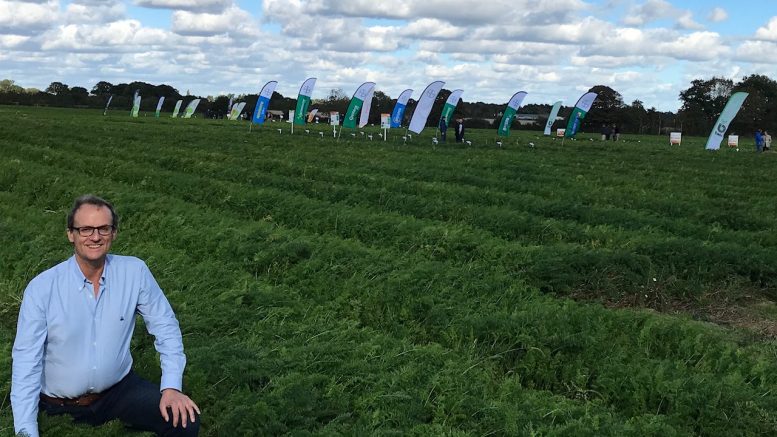British Carrot Growers Association Variety Demonstration & Trade Exhibition
Story and photos by John Stolarczyk, World Carrot Museum Curator
Market forces rule. That truth was evident at the British Carrot Growers Association Variety Demonstration and Trade Exhibition with certain types of carrots coming and going from the annual variety trial and exhibitors touting an increasing number of natural products to improve carrot production.
The field day, held in October at the premises of Tompsett Growers in Suffolk in southeast England, brought together growers, international seed companies and others associated with the UK carrot industry. The annual event, which was jointly organized by the Agriculture and Horticulture Development Board and the British Carrots Growers Association (BCGA), attracted more than 200 visitors.
“The 2017 BCGA Carrot Trials was a tremendous success. In spite of the ‘out-of-the-way’ location, it was attended by every significant carrot growing business in the UK, as well as overseas growers,” said Rodger Hobson, chairman of the BCGA. “Some great new varieties were on display, and the supply trade turned out in force.”

Clause displays Priam, a deep-orange carrot with a smooth finish and high tolerance to root breakage and red leaf virus.
Field Trials
Most growers and seed producers paid a visit to learn about developments and see the end product pulled directly from the field trial sites. The field trial allows attendees to see every type and color of carrot grown in the UK, all in one place. The demonstration gives growers an indication of varieties’ potential yield, flavor and color for next year’s crop planting.
This year’s trial included 53 carrot varieties from seven seed companies: Agility, AgriSeeds, Clause, Elsoms, Hazera, Nunhems and Rijk Zwaan. Trial plots are independently planted in the spring. Varieties were displayed in a mixture of types and plant densities and included tried-and-tested orange varieties, new introductions and examples of carrots in other colors.
Elsoms, which offers a selection of carrots bred by Bejo Zaden and developed from its own breeding program, displayed a wide range of Nantes and colored carrots including Norwich, Nairobi, Yellowstone and White Satin. Also attracting attention was Blanes, a Berlicum/Flakee processing carrot that has been specially developed to be larger and of higher quality, taste and consistency. Nazareth is another orange variety that displays good foliage and high resistance to disease, making it excellent for organic farming. It has also recorded good results for winter harvest and high yield.
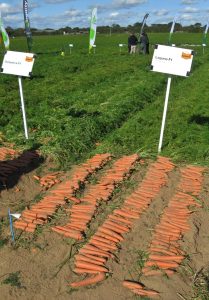
The British Carrot Growers Association’s 2017 variety trial includes 53 carrot cultivars.
Several varieties of colored carrots were displayed in the field as the UK market continues to search for a colored carrot that appeals to the masses. Sales of rainbow packs steadily increase, but there is little consumer demand for individual colored varieties; it is still very much a niche market with low sales compared to orange carrots. One variety of particular interest was Malbec, a pure red imperator grown by Seminis. This smooth and slender carrot of about 26cm in length and good flavor is said to be excellent for slicing and for creating “baby” imperators. It is expected that these vivid red carrots will sell well over the Christmas period. Seminis was also showing Belveta, a carrot with high carotene content, a dark orange color and improved flavor. It is expected to perform well in the health-conscious marketplace.
An orange variety introduced by Clause was Priam F1, a Nantes variant with high tolerance to red leaf virus and suitability for many soil types. It produces deep orange roots with a smooth finish and is highly tolerant to root breakage.
AgriSeeds displayed a new Nantes variant called A 9546, a very early type offering the potential advantage of entering the market before the competition.
Nunhems entered a new carrot named Brillyance F1, which had impressive results in the fight against cavity spot and Sclerotina. The Nunhems brand also includes Elegance F1. Billed as a producer of high yields, this smooth and consistent cylindrical root appears to be a possible “Nairobi beater.” It also has the benefit of retaining its premium color after storage. The company continues to strive to look for varieties that offer a high level of sustainability.
Hazera was showing the well-received Octavo F1, an early main-crop carrot from Vilmorin. It has high yield and strength from low wastage through mechanical damage and better-than-average cold tolerance. It also has good resistance to frost and cavity spot. Results from the trial show Octavo outperforming other varieties including some industry standards. A new yellow carrot, Gold Nugget F1, was also shown. The long, uniform carrot is less prone to the traditional green crown, and it has a sweet, juicy flavor and crunchy texture.
Interestingly, Chantenay types and “golf ball” variants such as Paris Market seem to have fallen out of favor; only one example of the former type was grown in the trial this year and no golf balls at all. This reflects the market demand and low profitability of these types of carrot.
A demonstration in the field by Cranfield University embraced key soil management challenges associated with carrot production. The university aims to identify and discuss the consequences of sub-surface compaction as well as surface capping. The compacting demonstration included the use of penetrometers and single-ring infiltrometers, giving farmers scientific insight into what is happening below the surface, along with suggested solutions.
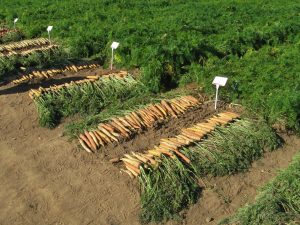
Several varieties of colored carrots are displayed in the field.
Trade Exhibition
The event’s trade exhibition provided ample networking and sales opportunities for the participating vendors and attendees. A common theme among several exhibitors was the demonstration of natural products to prevent carrot diseases and increase yields. This is seen as particularly important as the industry moves away from the application of chemicals perceived as harmful and as the prohibition or withdrawal of certain treatments continues.
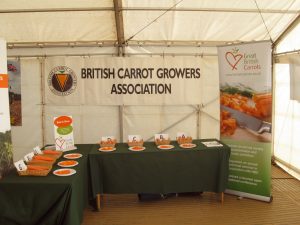
Samples of seven varieties are ready for tasting. Attendees scored each variety on visual appeal and taste. Agility’s Belveta earned the top score.
In the field, Bayer had an extensive display of Serenade ASO, a biological fungicide to prevent cavity spot and foliar diseases such as Sclerotina. The beneficial bacteria in Serenade interact with the plant in the root zone. It is applied prior to drilling. Trials have shown increased yield and improved plant quality.
In the indoor display, Soil Fertility Services described the advantages of Mega-Fos-Carrot, a foliar and soil feed which is biologically active. The product is based on beneficial soil-borne bacillus bacteria which form a symbiotic relationship with plant roots. Independent trial results have shown increased marketable yield and cavity spot reduction.
As farmers and breeders networked during the event, there was some discussion and debate about the impact of Brexit, the UK’s decision to leave the European Union. As the UK carrot industry is pretty much self-sufficient and provides about 97 percent of the supply of carrots for the UK market year round, it was considered there would be little impact on sales, as very little is either imported from or exported to Europe. However, one concern was the future of migrant workers as the negotiations were yet to make it clear what the future holds, and some of the UK seasonal carrot labor force comes from this source. The migrant labor issue is significant, and this could drive further mechanization and consolidation.
The carrot crop is Britain’s major root vegetable, producing over 700,000 tonnes of sold carrots each year from 9,000 hectares. This equates to approximately 160 carrots for every member of the population per year. The sales value of British carrots is around $380 million.
Overall, the UK carrot industry remains buoyant and profitable, despite economic uncertainty, and seems to be able to withstand whatever the markets and the ever-changeable weather throws at it.
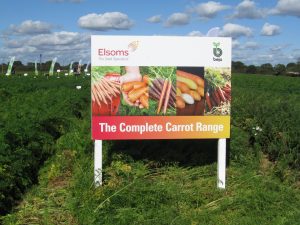
Seven seed companies, including Elsoms, showcase their selection of carrot cultivars in the trial.
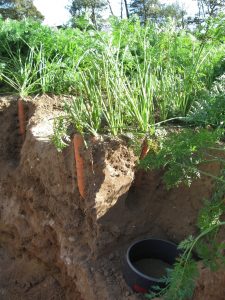
Cranfield University demonstrates soil management challenges in carrot production.

